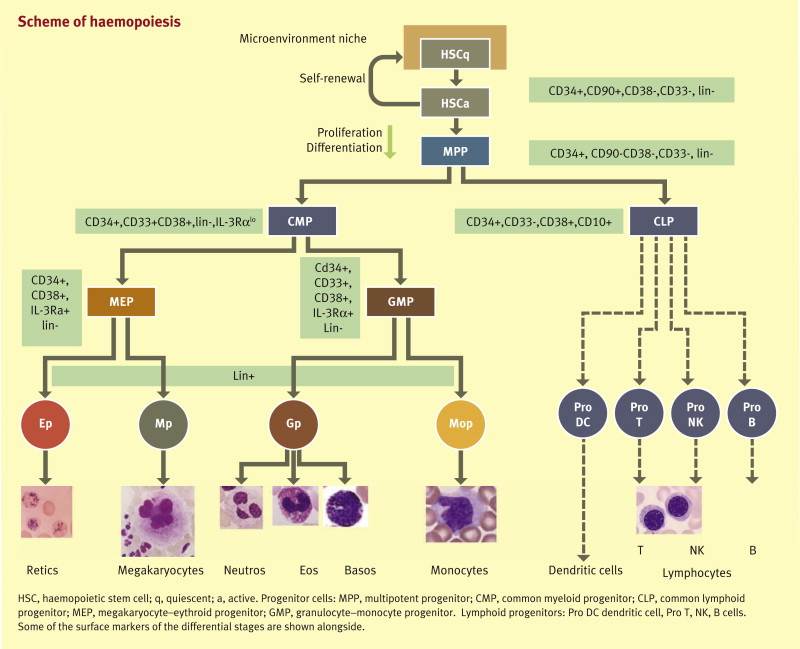Hematopoietic Progenitor Cell Markers
Related Symbol Search List
Immunology Background
About Hematopoietic Progenitor Cell Markers
Hematopoietic progenitor cells (HPCs) are pluripotent stem cells that give rise to all blood cell lineages. The identification and characterization of hematopoietic progenitor cells is critical to understanding hematopoiesis, the process of blood cell formation, and to advancing research in regenerative medicine and blood-related diseases. Hematopoietic progenitor cell markers are cell surface molecules or intracellular proteins that act as key identifiers for these cells. Significant progress has been made in the identification and characterization of hematopoietic progenitor cell markers. Early studies focused on identifying markers that distinguish hematopoietic progenitor cells from mature blood cells. For example, the cell surface marker CD34 has been widely used as a marker for hematopoietic stem cells (HSCs) and progenitor cells (HPCs) due to its selective expression on HSCs and progenitor cells. In addition, by analyzing gene expression profiles of individual cells, researchers have identified novel markers that define specific hematopoietic progenitor cell subsets and lineage commitments. For example, markers such as CD123 and CD44 serve as specific markers for hematopoietic progenitor cells (HPCs) that are biased toward the bone marrow (Buenrostro JD et al., 2018; Tusi BK et al., 2018). These advances in single-cell technology have revolutionized our understanding of HPC populations and their developmental trajectories.
 Fig.1 Differentiation of hematopoietic progenitor cells into immune cells: HSPCs can potentially differentiate into distinct immune cells in situ depending on the presence of locally elevated factors and cytokines. (Fischer KD, et al., 2013)
Fig.1 Differentiation of hematopoietic progenitor cells into immune cells: HSPCs can potentially differentiate into distinct immune cells in situ depending on the presence of locally elevated factors and cytokines. (Fischer KD, et al., 2013)
Functions of Hematopoietic Progenitor Cell Markers
- Cell Identification and Sorting
HPC markers allow for the identification, isolation, and purification of HPC populations from complex cellular mixtures. Flow cytometry and cell sorting techniques utilizing these markers can isolate specific HPC subsets for downstream analysis and functional studies.
- Lineage specification and fate determination
By examining the co-expression patterns of different markers, researchers can infer the lineage commitment of HPC subsets and investigate the molecular mechanisms that regulate their fate. molecular mechanisms that regulate their fate decisions.
- Disease diagnosis and monitoring
Altered expression patterns of HPC markers have been associated with a variety of hematologic disorders, including leukemia, lymphoma, and bone marrow failure syndromes. Monitoring the expression levels of these markers aids in disease diagnosis, prognosis, and treatment response assessment.
The expression and regulation of hematopoietic progenitor cell markers are controlled by complex molecular mechanisms. Several key mechanisms have been identified:
Mechanisms of Hematopoietic Progenitor Cell Markers
- Transcriptional regulation
Expression of HPC markers is controlled by transcription factors and regulatory elements that act in a lineage-specific manner. Transcriptional networks involving master regulators such as GATA-2, RUNX1, and PU.1 play a key role in HPC marker expression (Wilson et al., 2010).
- Epigenetic modifications
Epigenetic mechanisms, including DNA methylation and histone modifications, play a crucial role in the regulation of HPC marker expression. These modifications affect the accessibility of gene regulatory regions and may influence the differentiation potential of HPC (Buenrostro et al., 2018; Jeong et al., 2014).
- Signaling pathways
Multiple signaling pathways (e.g., Wnt, Notch, and cytokine signaling) contribute to the regulation of HPC marker expression and lineage stereotyping. Activation or inhibition of these pathways can influence HPC fate decisions (Pui et al., 1999).
- Microenvironmental interactions
The hematopoietic microenvironment (including cytokines, stromal cells, and extracellular matrix components) provides critical signals for HPC maintenance, self-renewal, and differentiation. These interactions influence HPC marker expression and lineage stereotyping (Morrison et al., 1997; Notta et al., 2016).
Available Resources of Hematopoietic Progenitor Cell Markers
Creative BioMart offers a wide range of products, services and resources to support hematopoietic stem cell differentiation related research, including products and resources related to hematopoietic progenitor cell markers, click to view all related molecules/targets and research reagents.
We are committed to supporting your research and providing reliable resources to advance the understanding of hematopoiesis and its application in regenerative medicine and disease treatment. For inquiries, collaborations, or more information about hematopoietic progenitor cell labeling, please contact our research team via the methods below.
References:
- Tusi BK, Wolock SL, Weinreb C, et al. Population snapshots predict early hematopoietic and erythroid hierarchies.Nature. 2018;555(7694):54-60.
- Buenrostro JD, Corces MR, Lareau CA, et al. Integrated Single-Cell Analysis Maps the Continuous Regulatory Landscape of Human Hematopoietic Differentiation. Cell. 2018;173(6):1535-1548.e16.
- Fischer KD, Agrawal DK. Hematopoietic stem and progenitor cells in inflammation and allergy. Front Immunol. 2013;4:428.
- Jeong M, Sun D, Luo M, et al. Large conserved domains of low DNA methylation maintained by Dnmt3a. Nature Genetics. 2014;46(1):17-23.
- Pui JC, Allman D, Xu L, et al. Notch1 expression in early lymphopoiesis influences B versus T lineage determination. Immunity. 1999;11(3):299-308.
- Simmons PJ, Torok-Storb B. Identification of stromal cell precursors in human bone marrow by a novel monoclonal antibody, STRO-1. Blood. 1991;78(1):55-62.
- Wilson NK, Foster SD, Wang X, et al. Combinatorial transcriptional control in blood stem/progenitor cells: genome-wide analysis of ten major transcriptional regulators. Cell Stem Cell. 2010;7(4):532-544.

